Dietmar Eckell travels the world to photograph plane wrecks where everyone survived. He told BBC Culture why he decided to find crashes with happy endings.
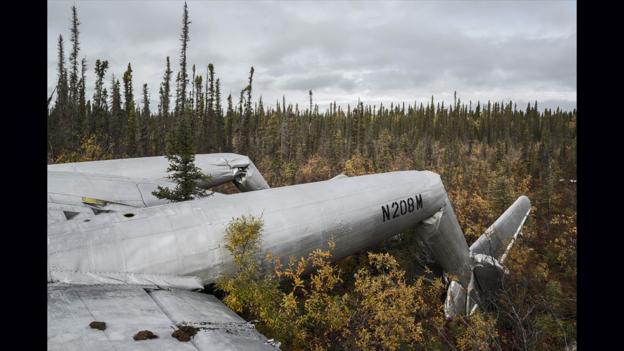
Fairchild C-82A Packet, Alaska
January 1965, Alaska. A Fairchild C-82 is flying above the Arctic Circle when it encounters trouble. “The plane’s electric system failed and they crash-landed in the night in the tundra forest, cutting down many trees. They survived at -45 degrees Celsius by making a big fire from the wood they had cut. It is very remote up there: they were really lucky that the fire was spotted by another plane three days later and they were rescued.” German photographer Dietmar Eckell is describing one of the stories he discovered while researching his Happy End project, which records plane crashes that had no fatalities. He has even been contacted by those who survived: raising the money to print a book of the photos last year, he was contacted by the pilot of this Fairchild C-82. “He sent me an email to thank me for writing down his story and documenting his plane almost 50 years after the crash.”

Cessna 310, Australia
Eckell became interested in documenting wrecks where everyone survived after he had his own crash: flying a paraglider with an engine to take aerial shots over the Mojave Desert in California, he went into a tailspin and landed alone with a broken ankle. “While recovering from surgery I had time to search the internet for crash landings in remote locations with no fatalities.” He makes sure they were happy endings before he documents them: “I found planes where all survived the landing but a few started walking and were never found – if [even] one passenger did not make it, the plane is not included in the series.”

Grumman Hu-16 Albatross, Mexico
He finds the planes online, via “pilot forums, archives, accident reports and websites about World War Two history”. Pinpointing the exact location can be tricky. “Once the story is confirmed I try to find it on Google Earth. If the resolution is not good enough I ask at the local airport and most of the time pilots can help. Sometimes I have to hire a plane to search from above. Then I hike out there.” This plane is on a beach 70km south of Puerto Escondido. Eckell photographed it in September 2010, six years after it crashed: “It was half sunk and already broken in two pieces. On the pictures I saw [online] from 2006 … the engines looked like they would still work. But in four years the Pacific had done massive damage.” He happened to be shooting when a storm was passing. “The clouds were changing every minute. The scenery looked unreal through the viewer of my camera … more like a painting – surreal – with different lines of clouds towards the horizon.” It might not be there for much longer. “With the force of the waves the wreck is disappearing fast.”
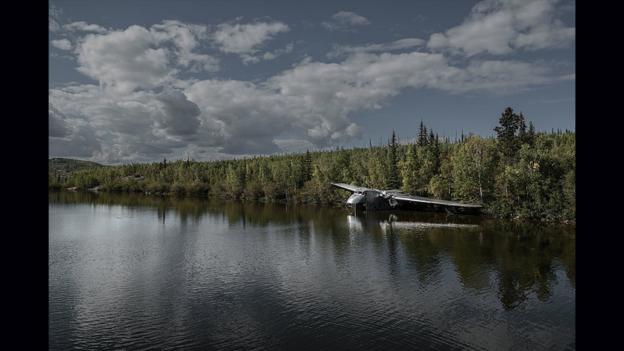
Bristol Type 170 Freighter, Northwest Territories, Canada
Eckell has even tracked down planes that locals don’t know about. “One time I needed a float plane to get to a lake 400km away and could not afford a charter. After three days I found a retired pilot who was willing to take me there – although he did not believe that I had the location of an abandoned plane that he had never heard of in his 30 years as a local pilot. He was very surprised when we found the plane in great condition resting on the side of the lake, where it had been since 1956.”

Avro Shackleton, Western Sahara
The journey on foot to a plane can be hard-going. “Physically the hikes through swamps with all your gear are tough because your feet are wet all day, there are mosquitos and every kilometre feels like 5km.” He remembers his attempt to reach this plane in Western Sahara as particularly dangerous. “It’s in an area that is controlled by Polisario rebels. After a 30-hour car ride from Morocco to Mauritania and a 26-hour ride on an ore train, I got to a mining town and there had to convince the local Polisario leader to take me over the border to the Western Sahara. I had the plane’s GPS location and we drove cross country to avoid getting caught by the Mauritanian military. We had a very old car and after an hour it developed a flat tyre; but everything worked out and I got great shots of an Avro Shackleton. What I found interesting was that the same rebel group also rescued the 19 passengers in 1994.”
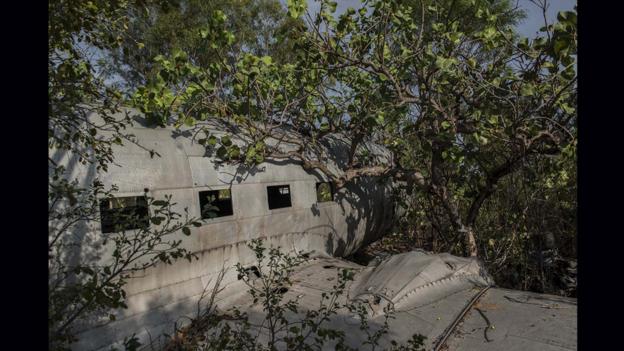
Douglas C-53 Skytrooper, Australia
Happy End is part of a longer-term project, called Restwert. “It started in the days before GPS when I was riding my motorbike in the remote Sahara following track descriptions with a map and compass. Some of the described landmarks along the way were car wrecks.” After photographing these ‘landmark wrecks’, Eckell went on to document abandoned mobile homes in the Mojave Desert. “With my photography I try to create curiosity for the story behind the picture.” This is one of the planes he has photographed most recently. It was forced to land in 1942 when the pilot missed the airport and ran out of fuel.

Douglas C-47 Skytrain, Yukon, Canada
There is an eerie dissonance between the wrecks and the majestic landscapes in the background, one that Eckell exploits to tell his story. “My ‘restwert’ photography is about abandoned objects forgotten in nowhere. When viewers see a photograph of a plane resting on a mountain or a tank sitting on a coral reef they want to know what happened … ‘Restwert’ is German for ‘residual value’ – the material value is written off, but the beauty, stories, and associations they trigger remain. I document these objects before nature takes them back to preserve their memory.” Ten people survived when this plane flew into the side of a mountain in February 1950. Eckell has visited the site twice. “I spent two hours at the wreck and still cannot imagine how they survived in February 1950 with temperatures in the -40s up there.”
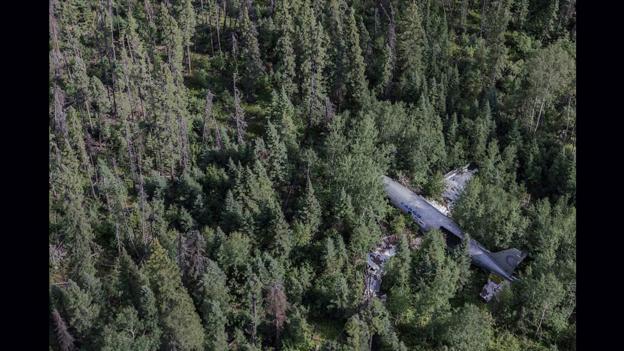
Curtiss C-46 Commando, Manitoba, Canada
He sees the wrecks as beautiful, both because they represent a happy ending and because many of the planes have survived the ravages of nature. “Old airplanes, like the DC-3 or Curtiss Commando, are design classics and timeless beauties. Aluminium does not erode so they still look pretty good even after 70 years in the bush.” Eckell draws on artists from a different age. “I was inspired by the shipwreck painters of the Romantic period and in my photography also look for dramatic skies, late light or fall colours.”
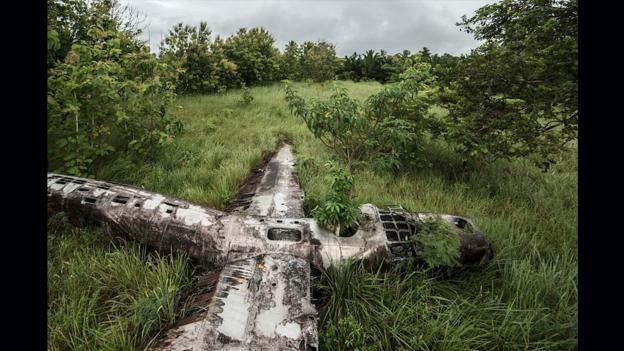
B-24 Liberator, Papua New Guinea
“The locals in Papua New Guinea called this wreck ‘Swamp Ghost’,” says Eckell, who photographed it in March 2013. “When we arrived a heavy rain started and we had to hide under the wing for over an hour.” Trying to get the shot he wanted from a high vantage point, he climbed a tree. “Soon after I noticed that it was the home of giant ants. By the time I could get to a decent shot position they were all over me and it was difficult to focus.” The B-24 was forced to land in a sago swamp in October 1943, after running low on fuel after a bombing mission. The crew successfully parachuted to the ground, and the two pilots were unhurt in the crash landing.

Curtiss C-46 Commando, Manitoba, Canada
“I was in Calgary documenting the abandoned Olympic Ski Jump,” says Eckell, describing his journey to photograph this plane, which crashed near Churchill in 1979. “I took my octocopter which got a lot of attention from the biologists on the train who work at the Polar Bear Research Centre in Churchill. It’s not a good idea to walk out to the wreck – this is polar bear country and they are hungry in summer because they haven’t eaten anything since the ice melted.” He got a lift from a local, and took the pictures quickly. “The plane is sitting on huge rocks – the crew was lucky to crash in November with snow softening the impact.”
SOURCE:::: Fiona Macdonald in http://www.bbc.com
Natarajan